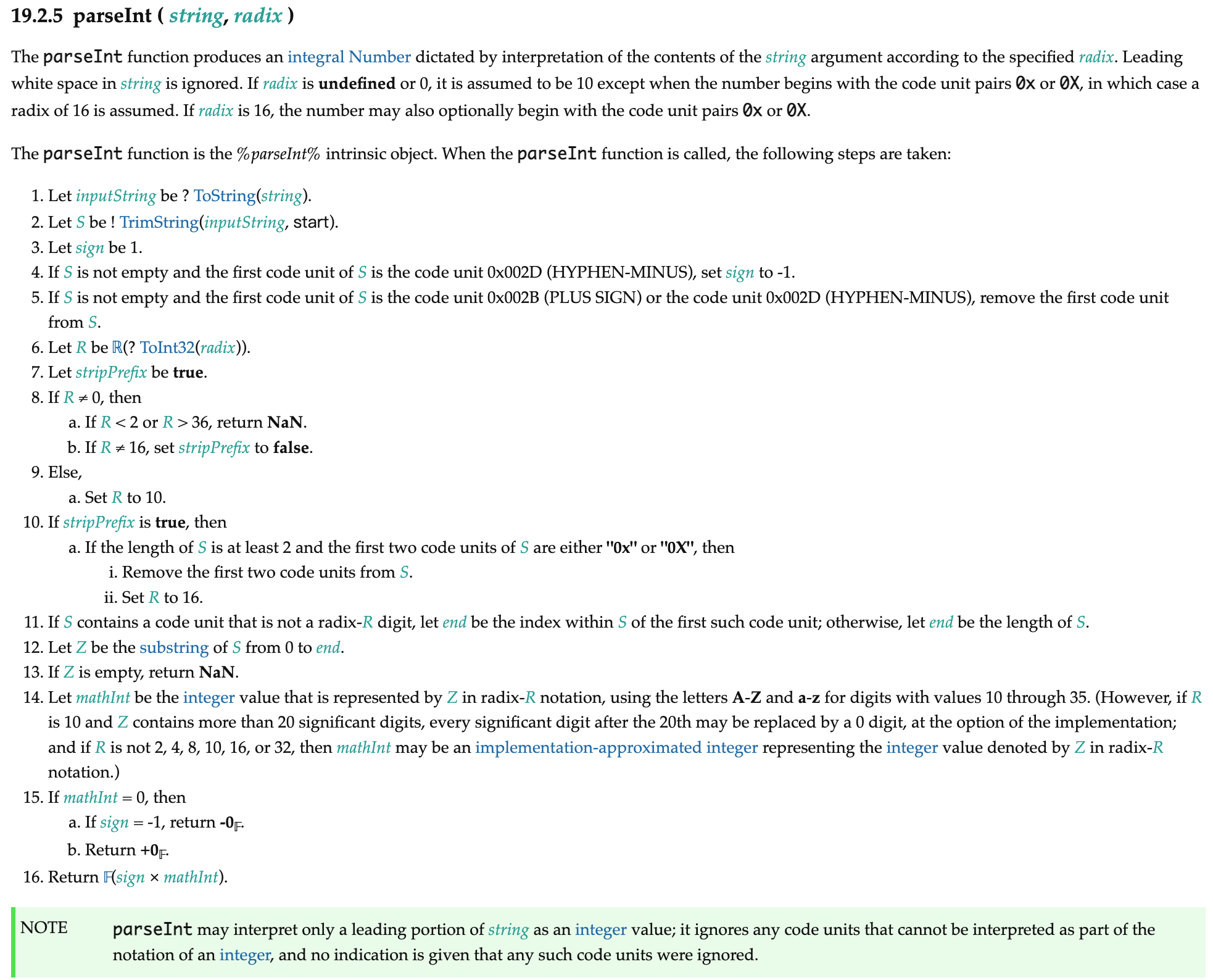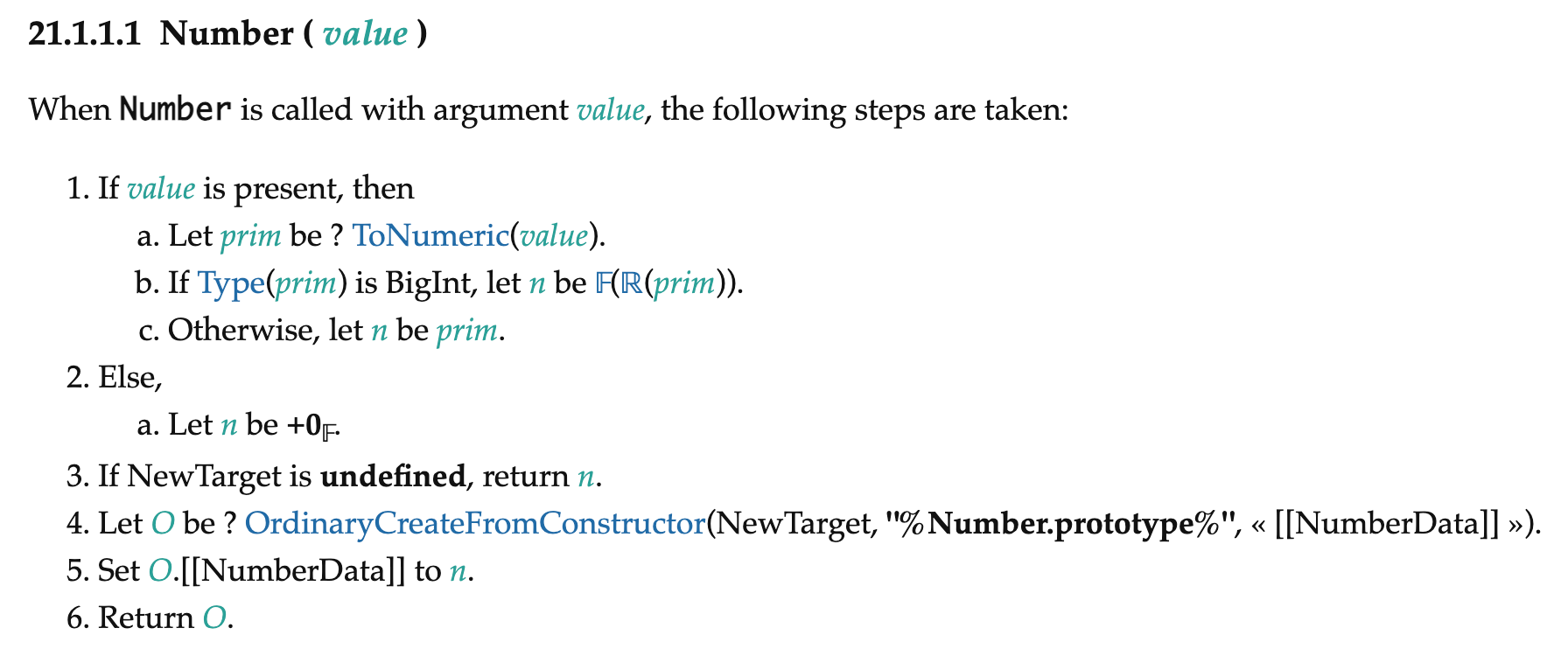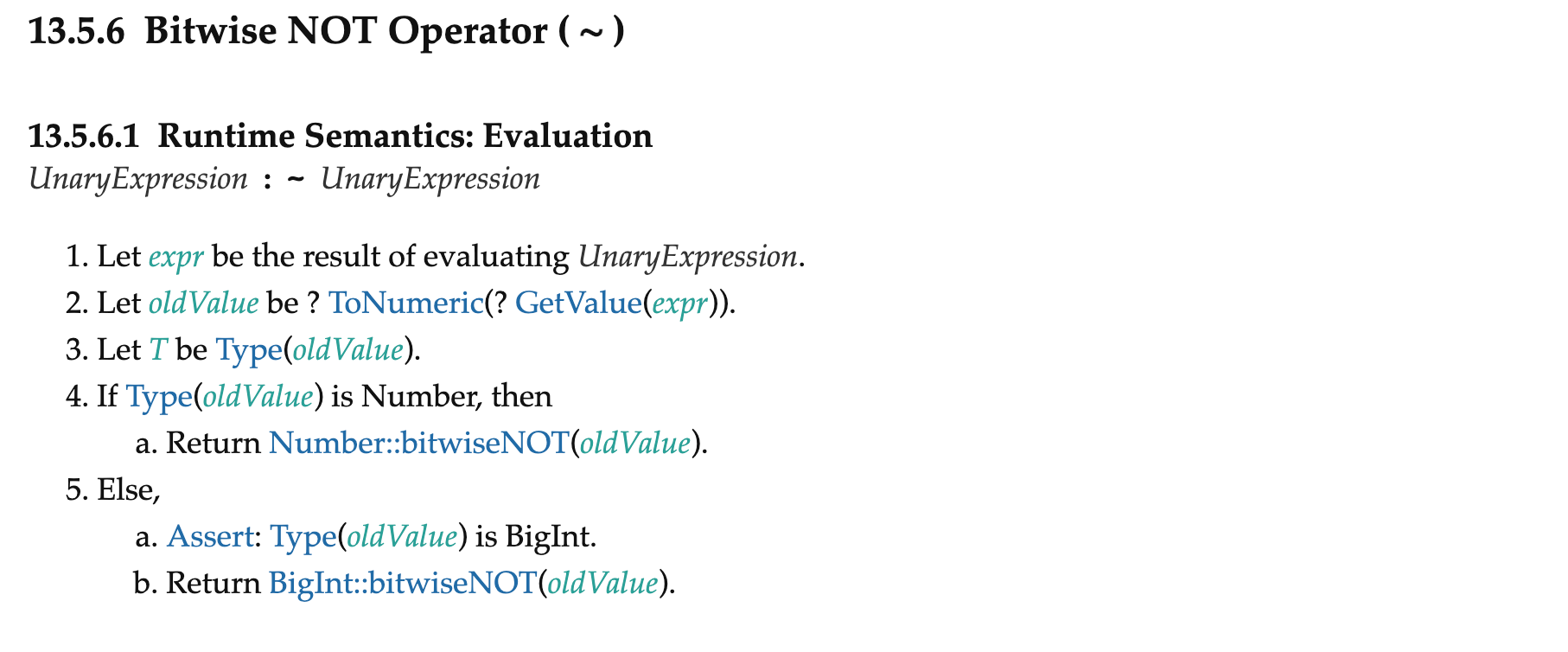JS 中,字符串转数值的方式有以下 9 种:
- parseInt()
- parseFloat()
- Number()
- Double tilde (~~) Operator
- Unary Operator (+)
- Math.floor()
- Multiply with number
- The Signed Right Shift Operator(>>)
- The Unsigned Right Shift Operator(>>>)
这几种方式对运行结果的差异,如下表所示:

对比表格的源码发布到了 https://airing.ursb.me/web/int.html,需要可自取。
除了运行结果上的存在差异之外,这些方法在性能上也存在着差异。在 NodeJS V8 环境下,这几个方法微基准测试的结果如下:
parseInt() x 19,140,190 ops/sec ±0.45% (92 runs sampled)
parseFloat() x 28,203,053 ops/sec ±0.25% (95 runs sampled)
Number() x 1,041,209,524 ops/sec ±0.20% (90 runs sampled)
Double tilde (~~) Operator x 1,035,220,963 ops/sec ±1.65% (97 runs sampled)
Math.floor() x 28,224,678 ops/sec ±0.23% (96 runs sampled)
Unary Operator (+) x 1,045,129,381 ops/sec ±0.17% (95 runs sampled)
Multiply with number x 1,044,176,084 ops/sec ±0.15% (93 runs sampled)
The Signed Right Shift Operator(>>) x 1,046,016,782 ops/sec ±0.11% (96 runs sampled)
The Unsigned Right Shift Operator(>>>) x 1,045,384,959 ops/sec ±0.08% (96 runs sampled)可见,parseInt(),parseFloat(),Math.floor() 的效率最低,只有其他运算 2% 左右的效率,而其中又以parseInt()最慢,仅有 1%。
为什么这些方法存在着这些差异?这些运算在引擎层又是如何被解释执行的?接下来将从 V8、JavaScriptCore、QuickJS 等主流 JS 引擎的视角,探究这些方法的具体实现。
首先来看看 parsrInt()。
1. parseInt()
ECMAScript (ECMA-262) parseInt

1.1 V8 中的 parseInt()
在 V8 [→ src/init/bootstrapper.cc] 中定义了 JS 语言内置的标准对象,我们可以找到其中关于 parseInt 的定义:
Handle<JSFunction> number_fun = InstallFunction(isolate_, global, "Number", JS_PRIMITIVE_WRAPPER_TYPE, JSPrimitiveWrapper::kHeaderSize, 0, isolate_->initial_object_prototype(), Builtin::kNumberConstructor);
// Install Number.parseInt and Global.parseInt.
Handle<JSFunction> parse_int_fun = SimpleInstallFunction(isolate_, number_fun, "parseInt", Builtin::kNumberParseInt, 2, true);
JSObject::AddProperty(isolate_, global_object, "parseInt", parse_int_fun,
native_context()->set_global_parse_int_fun(*parse_int_fun);
可以见,Number.parseInt 和全局对象的 parseInt 都是基于 SimpleInstallFunction 注册的,它会将 API 安装到 isolate 中,并将该方法与 Builtin 做绑定。JS 侧调用 pasreInt 即为引擎侧调用 Builtin::kNumberParseInt。
Builtin (Built-in Functions) 是 V8 中在 VM 运行时可执行的代码块,用于表达运行时对 VM 的更改。目前 V8 版本中 Builtin 有下述 5 种实现方式:
- Platform-dependent assembly language:很高效,但需要手动适配到所有平台,并且难以维护。
- C++:风格与runtime functions非常相似,可以访问 V8 强大的运行时功能,但通常不适合性能敏感区域。
- JavaScript:缓慢的运行时调用,受类型污染导致的不可预测的性能影响,以及复杂的 JS语义问题。现在 V8 不再使用 JavaScript 内置函数。
- CodeStubAssembler:提供高效的低级功能,非常接近汇编语言,同时保持平台依赖无关性和可读性。
- Torque:是 CodeStubAssembler 的改进版,其语法结合了 TypeScript 的一些特征,非常简单易读。强调在不损失性能的前提下尽量降低使用难度,让 Builtin 的开发更加容易一些。目前不少内置函数都是由 Torque 实现的。
回到前文 Builtin::kNumberParseInt 这个函数,在 [→ src/builtins/builtins.h] 中可以看到其定义:
// Convenience macro to avoid generating named accessors for all builtins.
#define BUILTIN_CODE(isolate, name) \
(isolate)->builtins()->code_handle(i::Builtin::k##name)
因此这个函数注册的原名是 NumberParseInt,实现在 [→ src/builtins/number.tq] 中,是个基于 Torque 的 Builtin 实现。
// ES6 #sec-number.parseint
transitioning javascript builtin NumberParseInt(
js-implicit context: NativeContext)(value: JSAny, radix: JSAny): Number {
return ParseInt(value, radix);
}
transitioning builtin ParseInt(implicit context: Context)(
input: JSAny, radix: JSAny): Number {
try {
// Check if radix should be 10 (i.e. undefined, 0 or 10).
if (radix != Undefined && !TaggedEqual(radix, SmiConstant(10)) &&
!TaggedEqual(radix, SmiConstant(0))) {
goto CallRuntime;
}
typeswitch (input) {
case (s: Smi): {
return s;
}
case (h: HeapNumber): {
// Check if the input value is in Signed32 range.
const asFloat64: float64 = Convert<float64>(h);
const asInt32: int32 = Signed(TruncateFloat64ToWord32(asFloat64));
// The sense of comparison is important for the NaN case.
if (asFloat64 == ChangeInt32ToFloat64(asInt32)) goto Int32(asInt32);
// Check if the absolute value of input is in the [1,1<<31[ range. Call
// the runtime for the range [0,1[ because the result could be -0.
const kMaxAbsValue: float64 = 2147483648.0;
const absInput: float64 = math::Float64Abs(asFloat64);
if (absInput < kMaxAbsValue && absInput >= 1.0) goto Int32(asInt32);
goto CallRuntime;
}
case (s: String): {
goto String(s);
}
case (HeapObject): {
goto CallRuntime;
}
}
} label Int32(i: int32) {
return ChangeInt32ToTagged(i);
} label String(s: String) {
// Check if the string is a cached array index.
const hash: NameHash = s.raw_hash_field;
if (IsIntegerIndex(hash) &&
hash.array_index_length < kMaxCachedArrayIndexLength) {
const arrayIndex: uint32 = hash.array_index_value;
return SmiFromUint32(arrayIndex);
}
// Fall back to the runtime.
goto CallRuntime;
} label CallRuntime {
tail runtime::StringParseInt(input, radix);
}
}
看这段代码前,先科普下 V8 中的几个数据结构:(V8 所有数据结构的定义可以见 [→ src/objects/objects.h])
- Smi:继承自 Object,immediate small integer,只有 31 位
- HeapObject:继承自 Object,superclass for everything allocated in the heap
- PrimitiveHeapObject:继承自 HeapObject
- HeapNumber:继承自 PrimitiveHeapObject,存储了数字的堆对象,用于保存大整形的对象。
我们知道 parseInt 接收两个形参, 即 parseInt(string, radix),此处亦如是。 实现流程如下:
- 首先判断
radix是否没传或者传了 0 或 10,如果不是,那么则不是十进制的转换,就走 runtime 中提供的StringParseInt函数runtime::StringParseInt; - 如果是十进制转换就继续走,判断第一个参数的数据类型。
- 如果是 Smi 或者是没有越界(超 31 位)的 HeapNumber,那么就直接 return 入参,相当于没有转化;否则同样走
runtime::StringParseInt。注意如果这里越界了就会走ChangeInt32ToTagged,其为 CodeStubAssembler 实现的一个函数,会强转 Int32,如果当前执行环境不允许溢出 32 位,那么转换之后的数字就会不合预期。 - 如果是 String,则判断是否是 hash,如果是的就找到对应整型 value 返回;否则依然走
runtime::StringParseInt。
那么焦点来到了 runtime::StringParseInt。[→ src/runtime/runtime-numbers.cc]
// ES6 18.2.5 parseInt(string, radix) slow path
RUNTIME_FUNCTION(Runtime_StringParseInt) {
HandleScope handle_scope(isolate);
DCHECK_EQ(2, args.length());
Handle<Object> string = args.at(0);
Handle<Object> radix = args.at(1);
// Convert {string} to a String first, and flatten it.
Handle<String> subject;
ASSIGN_RETURN_FAILURE_ON_EXCEPTION(isolate, subject,
Object::ToString(isolate, string));
subject = String::Flatten(isolate, subject);
// Convert {radix} to Int32.
if (!radix->IsNumber()) {
ASSIGN_RETURN_FAILURE_ON_EXCEPTION(isolate, radix,
Object::ToNumber(isolate, radix));
}
int radix32 = DoubleToInt32(radix->Number());
if (radix32 != 0 && (radix32 < 2 || radix32 > 36)) {
return ReadOnlyRoots(isolate).nan_value();
}
double result = StringToInt(isolate, subject, radix32);
return *isolate->factory()->NewNumber(result);
}
这段逻辑比较简单,就不再一行行解读了。值得注意的是,根据标准,如果 radix 不在 2~36 的范围内,会返回 NaN。
1.2 JavaScriptCore 中的 parseInt()
接着我们来看看 JavaScriptCore 中的 parseInt()。
JavaScriptCore 中关于 JS 语言内置对象的注册都在 [→ runtime/JSGlobalObjectFuntions.cpp] 文件中:
JSC_DEFINE_HOST_FUNCTION(globalFuncParseInt, (JSGlobalObject* globalObject, CallFrame* callFrame))
{
JSValue value = callFrame->argument(0);
JSValue radixValue = callFrame->argument(1);
// Optimized handling for numbers:
// If the argument is 0 or a number in range 10^-6 <= n < INT_MAX+1, then parseInt
// results in a truncation to integer. In the case of -0, this is converted to 0.
//
// This is also a truncation for values in the range INT_MAX+1 <= n < 10^21,
// however these values cannot be trivially truncated to int since 10^21 exceeds
// even the int64_t range. Negative numbers are a little trickier, the case for
// values in the range -10^21 < n <= -1 are similar to those for integer, but
// values in the range -1 < n <= -10^-6 need to truncate to -0, not 0.
static const double tenToTheMinus6 = 0.000001;
static const double intMaxPlusOne = 2147483648.0;
if (value.isNumber()) {
double n = value.asNumber();
if (((n < intMaxPlusOne && n >= tenToTheMinus6) || !n) && radixValue.isUndefinedOrNull())
return JSValue::encode(jsNumber(static_cast<int32_t>(n)));
}
// If ToString throws, we shouldn't call ToInt32.
return toStringView(globalObject, value, [&] (StringView view) {
return JSValue::encode(jsNumber(parseInt(view, radixValue.toInt32(globalObject))));
});
}
WebKit 中的代码注释都很详尽易读,这里也不再解读了。最后,会调用 parseInt,JavaScriptCore 的 parseInt 的实现全放在了 [→ runtime/ParseInt.h] 中,核心代码如下:
ALWAYS_INLINE static bool isStrWhiteSpace(UChar c)
{
// https://tc39.github.io/ecma262/#sec-tonumber-applied-to-the-string-type
return Lexer<UChar>::isWhiteSpace(c) || Lexer<UChar>::isLineTerminator(c);
}
// ES5.1 15.1.2.2
template <typename CharType>
ALWAYS_INLINE
static double parseInt(StringView s, const CharType* data, int radix)
{
// 1. Let inputString be ToString(string).
// 2. Let S be a newly created substring of inputString consisting of the first character that is not a
// StrWhiteSpaceChar and all characters following that character. (In other words, remove leading white
// space.) If inputString does not contain any such characters, let S be the empty string.
int length = s.length();
int p = 0;
while (p < length && isStrWhiteSpace(data[p]))
++p;
// 3. Let sign be 1.
// 4. If S is not empty and the first character of S is a minus sign -, let sign be -1.
// 5. If S is not empty and the first character of S is a plus sign + or a minus sign -, then remove the first character from S.
double sign = 1;
if (p < length) {
if (data[p] == '+')
++p;
else if (data[p] == '-') {
sign = -1;
++p;
}
}
// 6. Let R = ToInt32(radix).
// 7. Let stripPrefix be true.
// 8. If R != 0,then
// b. If R != 16, let stripPrefix be false.
// 9. Else, R == 0
// a. LetR = 10.
// 10. If stripPrefix is true, then
// a. If the length of S is at least 2 and the first two characters of S are either ―0x or ―0X,
// then remove the first two characters from S and let R = 16.
// 11. If S contains any character that is not a radix-R digit, then let Z be the substring of S
// consisting of all characters before the first such character; otherwise, let Z be S.
if ((radix == 0 || radix == 16) && length - p >= 2 && data[p] == '0' && (data[p + 1] == 'x' || data[p + 1] == 'X')) {
radix = 16;
p += 2;
} else if (radix == 0)
radix = 10;
// 8.a If R < 2 or R > 36, then return NaN.
if (radix < 2 || radix > 36)
return PNaN;
// 13. Let mathInt be the mathematical integer value that is represented by Z in radix-R notation, using the letters
// A-Z and a-z for digits with values 10 through 35. (However, if R is 10 and Z contains more than 20 significant
// digits, every significant digit after the 20th may be replaced by a 0 digit, at the option of the implementation;
// and if R is not 2, 4, 8, 10, 16, or 32, then mathInt may be an implementation-dependent approximation to the
// mathematical integer value that is represented by Z in radix-R notation.)
// 14. Let number be the Number value for mathInt.
int firstDigitPosition = p;
bool sawDigit = false;
double number = 0;
while (p < length) {
int digit = parseDigit(data[p], radix);
if (digit == -1)
break;
sawDigit = true;
number *= radix;
number += digit;
++p;
}
// 12. If Z is empty, return NaN.
if (!sawDigit)
return PNaN;
// Alternate code path for certain large numbers.
if (number >= mantissaOverflowLowerBound) {
if (radix == 10) {
size_t parsedLength;
number = parseDouble(s.substring(firstDigitPosition, p - firstDigitPosition), parsedLength);
} else if (radix == 2 || radix == 4 || radix == 8 || radix == 16 || radix == 32)
number = parseIntOverflow(s.substring(firstDigitPosition, p - firstDigitPosition), radix);
}
// 15. Return sign x number.
return sign * number;
}
ALWAYS_INLINE static double parseInt(StringView s, int radix)
{
if (s.is8Bit())
return parseInt(s, s.characters8(), radix);
return parseInt(s, s.characters16(), radix);
}
template<typename CallbackWhenNoException>
static ALWAYS_INLINE typename std::invoke_result<CallbackWhenNoException, StringView>::type toStringView(JSGlobalObject* globalObject, JSValue value, CallbackWhenNoException callback)
{
VM& vm = getVM(globalObject);
auto scope = DECLARE_THROW_SCOPE(vm);
JSString* string = value.toStringOrNull(globalObject);
EXCEPTION_ASSERT(!!scope.exception() == !string);
if (UNLIKELY(!string))
return { };
auto viewWithString = string->viewWithUnderlyingString(globalObject);
RETURN_IF_EXCEPTION(scope, { });
RELEASE_AND_RETURN(scope, callback(viewWithString.view));
}
// Mapping from integers 0..35 to digit identifying this value, for radix 2..36.
const char radixDigits[] = "0123456789abcdefghijklmnopqrstuvwxyz";
直接贴出了代码,因为 JavaScriptCore 中的 API 都是严格按照 ECMAScript (ECMA-262) parseInt 标准一步一步按流程实现,可读性和注释也很好,强烈建议读者自己阅读一下,此处不再解读。
1.3 QuickJS 中的 parseInt()
QuickJS 的核心代码都在 [→ quickjs.c] 中,首先是 parseInt 的注册代码:
/* global object */
static const JSCFunctionListEntry js_global_funcs[] = {
JS_CFUNC_DEF("parseInt", 2, js_parseInt ),
//...
}
js_parseInt 的实现逻辑如下:
static JSValue js_parseInt(JSContext *ctx, JSValueConst this_val,
int argc, JSValueConst *argv)
{
const char *str, *p;
int radix, flags;
JSValue ret;
str = JS_ToCString(ctx, argv[0]);
if (!str)
return JS_EXCEPTION;
if (JS_ToInt32(ctx, &radix, argv[1])) {
JS_FreeCString(ctx, str);
return JS_EXCEPTION;
}
if (radix != 0 && (radix < 2 || radix > 36)) {
ret = JS_NAN;
} else {
p = str;
p += skip_spaces(p);
flags = ATOD_INT_ONLY | ATOD_ACCEPT_PREFIX_AFTER_SIGN;
ret = js_atof(ctx, p, NULL, radix, flags);
}
JS_FreeCString(ctx, str);
return ret;
}
Bellard 大神的代码注释很少,但同时也非常精炼。
至此,本文介绍完了三个引擎下各自 parseInt 的实现,三者都是基于标准的实现,但由于代码风格不同,读起来也像是阅读三个风格不同散文大家的作品。
不过标准和实现,我们可以发现 parseInt 在真正执行字符串转数字这个操作做了非常多的前置操作,如入参合法判断、入参默认值、字符串格式判断与规整化、越界判断等等,最后再交由 runtime 处理。因此,我们不难推出其效率略低的原因。
接下来,我们再简单看看 parseFloat。
2. parseFloat()
ECMAScript (ECMA-262) parseFloat

根据标准,parseFloat 与 parseInt 有两点明显的不同:
- 仅支持一个入参,不支持进制转换
- 返回值支持浮点型
2.1 V8 中的 parseFloat()
V8 中 parseFloat 的相关逻辑都紧挨着 parseInt,这里直接贴出关键实现:
[→ src/builtins/number.tq]
// ES6 #sec-number.parsefloat
transitioning javascript builtin NumberParseFloat(
js-implicit context: NativeContext)(value: JSAny): Number {
try {
typeswitch (value) {
case (s: Smi): {
return s;
}
case (h: HeapNumber): {
// The input is already a Number. Take care of -0.
// The sense of comparison is important for the NaN case.
return (Convert<float64>(h) == 0) ? SmiConstant(0) : h;
}
case (s: String): {
goto String(s);
}
case (HeapObject): {
goto String(string::ToString(context, value));
}
}
} label String(s: String) {
// Check if the string is a cached array index.
const hash: NameHash = s.raw_hash_field;
if (IsIntegerIndex(hash) &&
hash.array_index_length < kMaxCachedArrayIndexLength) {
const arrayIndex: uint32 = hash.array_index_value;
return SmiFromUint32(arrayIndex);
}
// Fall back to the runtime to convert string to a number.
return runtime::StringParseFloat(s);
}
}
[→ src/runtime/runtime-numbers.cc]
// ES6 18.2.4 parseFloat(string)
RUNTIME_FUNCTION(Runtime_StringParseFloat) {
HandleScope shs(isolate);
DCHECK_EQ(1, args.length());
Handle<String> subject = args.at<String>(0);
double value = StringToDouble(isolate, subject, ALLOW_TRAILING_JUNK,
std::numeric_limits<double>::quiet_NaN());
return *isolate->factory()->NewNumber(value);
}
因标准中的流程更为简易,因此较 parseInt 而言, parseFloat 更加简单易读。
2.2 JavaScriptCore 中的 parseFloat()
在 JavaScriptCore 中,parseFloat 的逻辑则更加简洁明了:
static double parseFloat(StringView s)
{
unsigned size = s.length();
if (size == 1) {
UChar c = s[0];
if (isASCIIDigit(c))
return c - '0';
return PNaN;
}
if (s.is8Bit()) {
const LChar* data = s.characters8();
const LChar* end = data + size;
// Skip leading white space.
for (; data < end; ++data) {
if (!isStrWhiteSpace(*data))
break;
}
// Empty string.
if (data == end)
return PNaN;
return jsStrDecimalLiteral(data, end);
}
const UChar* data = s.characters16();
const UChar* end = data + size;
// Skip leading white space.
for (; data < end; ++data) {
if (!isStrWhiteSpace(*data))
break;
}
// Empty string.
if (data == end)
return PNaN;
return jsStrDecimalLiteral(data, end);
}
2.3 QuickJS 中的 parseFloat()
而对比 JavaScriptCore,QuickJS 则短短 12 行:
[→ quickjs.c]
static JSValue js_parseFloat(JSContext *ctx, JSValueConst this_val,
int argc, JSValueConst *argv)
{
const char *str, *p;
JSValue ret;
str = JS_ToCString(ctx, argv[0]);
if (!str)
return JS_EXCEPTION;
p = str;
p += skip_spaces(p);
ret = js_atof(ctx, p, NULL, 10, 0);
JS_FreeCString(ctx, str);
return ret;
}
不过对比之后可以知道,QuickJS 这里之所以短小,是没有做 ASCII 和 8Bit 的兼容。阅读 ECMAScript (ECMA-262) parseFloat 之后可以发现,QuickJS 这里的处理其实没有什么问题,最新的标准中并没有要求解释器要这样的兼容。
3. Number()
ECMAScript (ECMA-262) Number ( value )

3.1 V8 中的 Number()
Number 作为全局对象,定义还是在 [→ src/init/bootstrapper.cc] 中,在前文介绍 Number.parseInt 的注册时已然介绍过,我们回顾下:
Handle<JSFunction> number_fun = InstallFunction(
isolate_, global, "Number", JS_PRIMITIVE_WRAPPER_TYPE,
JSPrimitiveWrapper::kHeaderSize, 0,
isolate_->initial_object_prototype(), Builtin::kNumberConstructor);
number_fun->shared().DontAdaptArguments();
number_fun->shared().set_length(1);
InstallWithIntrinsicDefaultProto(isolate_, number_fun,
Context::NUMBER_FUNCTION_INDEX);
// Create the %NumberPrototype%
Handle<JSPrimitiveWrapper> prototype = Handle<JSPrimitiveWrapper>::cast(
factory->NewJSObject(number_fun, AllocationType::kOld));
prototype->set_value(Smi::zero());
JSFunction::SetPrototype(number_fun, prototype);
// Install the "constructor" property on the {prototype}.
JSObject::AddProperty(isolate_, prototype, factory->constructor_string(),
number_fun, DONT_ENUM);
这段代码处理注册了 Number 这个对象之外,还初始化了它的原型链,并把构造函数添加到了它的原型链上。构造函数 Builtin::kNumberConstructor 是 Torque 实现的 Builtin,[→ src/builtins/constructor.tq] ,具体实现如下:
// ES #sec-number-constructor
transitioning javascript builtin
NumberConstructor(
js-implicit context: NativeContext, receiver: JSAny, newTarget: JSAny,
target: JSFunction)(...arguments): JSAny {
// 1. If no arguments were passed to this function invocation, let n be +0.
let n: Number = 0;
if (arguments.length > 0) {
// 2. Else,
// a. Let prim be ? ToNumeric(value).
// b. If Type(prim) is BigInt, let n be the Number value for prim.
// c. Otherwise, let n be prim.
const value = arguments[0];
n = ToNumber(value, BigIntHandling::kConvertToNumber);
}
// 3. If NewTarget is undefined, return n.
if (newTarget == Undefined) return n;
// 4. Let O be ? OrdinaryCreateFromConstructor(NewTarget,
// "%NumberPrototype%", « [[NumberData]] »).
// 5. Set O.[[NumberData]] to n.
// 6. Return O.
// We ignore the normal target parameter and load the value from the
// current frame here in order to reduce register pressure on the fast path.
const target: JSFunction = LoadTargetFromFrame();
const result = UnsafeCast<JSPrimitiveWrapper>(
FastNewObject(context, target, UnsafeCast<JSReceiver>(newTarget)));
result.value = n;
return result;
}
注释中的 1-6 一一对应着[ECMAScript (ECMA-262) Number ( value )]标准中的流程 1-6,因此本文不再花篇章赘述其实现。需要注意的是,标准中明确说明了 Number 是支持 BigInt 的,各引擎的实现也着重注意了这点,这也证明了我们之前运算对照表中的结果。
3.2 JavaScriptCore 中的 Number()
JavaScriptCore 中的这段代码则缺少注释,但逻辑上与 V8 一模一样,遵循标准:
[→ runtime/NumberConstructor.cpp]
// ECMA 15.7.1
JSC_DEFINE_HOST_FUNCTION(constructNumberConstructor, (JSGlobalObject* globalObject, CallFrame* callFrame))
{
VM& vm = globalObject->vm();
auto scope = DECLARE_THROW_SCOPE(vm);
double n = 0;
if (callFrame->argumentCount()) {
JSValue numeric = callFrame->uncheckedArgument(0).toNumeric(globalObject);
RETURN_IF_EXCEPTION(scope, { });
if (numeric.isNumber())
n = numeric.asNumber();
else {
ASSERT(numeric.isBigInt());
numeric = JSBigInt::toNumber(numeric);
ASSERT(numeric.isNumber());
n = numeric.asNumber();
}
}
JSObject* newTarget = asObject(callFrame->newTarget());
Structure* structure = JSC_GET_DERIVED_STRUCTURE(vm, numberObjectStructure, newTarget, callFrame->jsCallee());
RETURN_IF_EXCEPTION(scope, { });
NumberObject* object = NumberObject::create(vm, structure);
object->setInternalValue(vm, jsNumber(n));
return JSValue::encode(object);
}
3.3 QuickJS 中的 Number()
Number 对象及其原型链的注册代码如下所示:
[→ quickjs.c]
void JS_AddIntrinsicBaseObjects(JSContext *ctx)
{
//...
/* Number */
ctx->class_proto[JS_CLASS_NUMBER] = JS_NewObjectProtoClass(ctx, ctx->class_proto[JS_CLASS_OBJECT], JS_CLASS_NUMBER);
JS_SetObjectData(ctx, ctx->class_proto[JS_CLASS_NUMBER], JS_NewInt32(ctx, 0));
JS_SetPropertyFunctionList(ctx, ctx->class_proto[JS_CLASS_NUMBER], js_number_proto_funcs, countof(js_number_proto_funcs));
number_obj = JS_NewGlobalCConstructor(ctx, "Number", js_number_constructor, 1, ctx->class_proto[JS_CLASS_NUMBER]);
JS_SetPropertyFunctionList(ctx, number_obj, js_number_funcs, countof(js_number_funcs));
}
同样的时候,在原型链注册的时候绑上了构造函数 js_number_constructor :
static JSValue js_number_constructor(JSContext *ctx, JSValueConst new_target,
int argc, JSValueConst *argv)
{
JSValue val, obj;
if (argc == 0) {
val = JS_NewInt32(ctx, 0);
} else {
val = JS_ToNumeric(ctx, argv[0]);
if (JS_IsException(val))
return val;
switch(JS_VALUE_GET_TAG(val)) {
#ifdef CONFIG_BIGNUM
case JS_TAG_BIG_INT:
case JS_TAG_BIG_FLOAT:
{
JSBigFloat *p = JS_VALUE_GET_PTR(val);
double d;
bf_get_float64(&p->num, &d, BF_RNDN);
JS_FreeValue(ctx, val);
val = __JS_NewFloat64(ctx, d);
}
break;
case JS_TAG_BIG_DECIMAL:
val = JS_ToStringFree(ctx, val);
if (JS_IsException(val))
return val;
val = JS_ToNumberFree(ctx, val);
if (JS_IsException(val))
return val;
break;
#endif
default:
break;
}
}
if (!JS_IsUndefined(new_target)) {
obj = js_create_from_ctor(ctx, new_target, JS_CLASS_NUMBER);
if (!JS_IsException(obj))
JS_SetObjectData(ctx, obj, val);
return obj;
} else {
return val;
}
}
值得关注的是 QuickJS 追求精简小巧,因此可以自行配置是否支持 BigInt,其余逻辑依然遵循标准。
4. Double tilde (~~) Operator
ECMAScript (ECMA-262) Bitwise NOT Operator

使用 ~ 运算符利用到了标准中的第 2 步,对被计算的值做类型转换,从而将字符串转成数值。这里我们关注这个环节具体是在引擎中的哪个步骤完成的。
4.1 V8 中的 BitwiseNot
首先看看 V8 中对一元运算符的判断:
[→ src/parsing/token.h]
static bool IsUnaryOp(Value op) { return base::IsInRange(op, ADD, VOID); }
定义在 ADD 和 VOID 范围内的 op,都是一元运算符,具体包括 (可见 [→ src/parsing/token.h]),其中 SUB 和 ADD 定义在二元运算符列表的末端,在 IsUnaryOp 中它们也会命中一元符的判断:
E(T, ADD, "+", 12)
E(T, SUB, "-", 12)
T(NOT, "!", 0)
T(BIT_NOT, "~", 0)
K(DELETE, "delete", 0)
K(TYPEOF, "typeof", 0)
K(VOID, "void", 0)
之后进入语法分析阶段,解析 AST 树的过程中,遇到一元运算符会做相应的处理,先调用 ParseUnaryOrPrefixExpression 之后构建一元运算符表达式 BuildUnaryExpression:
[→ src/parsing/parser-base.h]
template <typename Impl>
typename ParserBase<Impl>::ExpressionT
ParserBase<Impl>::ParseUnaryExpression() {
// UnaryExpression ::
// PostfixExpression
// 'delete' UnaryExpression
// 'void' UnaryExpression
// 'typeof' UnaryExpression
// '++' UnaryExpression
// '--' UnaryExpression
// '+' UnaryExpression
// '-' UnaryExpression
// '~' UnaryExpression
// '!' UnaryExpression
// [+Await] AwaitExpression[?Yield]
Token::Value op = peek();
// 一元运算符处理
if (Token::IsUnaryOrCountOp(op)) return ParseUnaryOrPrefixExpression();
if (is_await_allowed() && op == Token::AWAIT) {
// await 处理
return ParseAwaitExpression();
}
return ParsePostfixExpression();
}
template <typename Impl>
typename ParserBase<Impl>::ExpressionT
ParserBase<Impl>::ParseUnaryOrPrefixExpression() {
//...
//...
// Allow the parser's implementation to rewrite the expression.
return impl()->BuildUnaryExpression(expression, op, pos);
}
[→ src/parsing/parser.cc]
Expression* Parser::BuildUnaryExpression(Expression* expression,
Token::Value op, int pos) {
DCHECK_NOT_NULL(expression);
const Literal* literal = expression->AsLiteral();
if (literal != nullptr) {
// !
if (op == Token::NOT) {
// Convert the literal to a boolean condition and negate it.
return factory()->NewBooleanLiteral(literal->ToBooleanIsFalse(), pos);
} else if (literal->IsNumberLiteral()) {
// Compute some expressions involving only number literals.
double value = literal->AsNumber();
switch (op) {
// +
case Token::ADD:
return expression;
// -
case Token::SUB:
return factory()->NewNumberLiteral(-value, pos);
// ~
case Token::BIT_NOT:
return factory()->NewNumberLiteral(~DoubleToInt32(value), pos);
default:
break;
}
}
}
return factory()->NewUnaryOperation(op, expression, pos);
}
如果字面量是数值型且一元运算符此刻不是 NOT(!),那么会把 Value 会转成 Number,如果是 BIT_NOT 再转成 INT32 进行取反运算。
4.2 JavaScriptCore 中的 BitwiseNot
同样在语法分析生成 AST 阶段,处理到 TILDE(~) 这个 token 后,创建表达式时会做类型转换的工作:
[→ Parser/Parser.cpp]
template <typename LexerType>
template <class TreeBuilder> TreeExpression Parser<LexerType>::parseUnaryExpression(TreeBuilder& context)
{
//... 省略无关代码
while (tokenStackDepth) {
switch (tokenType) {
//... 省略无关代码
// ~
case TILDE:
expr = context.makeBitwiseNotNode(location, expr);
break;
// +
case PLUS:
expr = context.createUnaryPlus(location, expr);
break;
//... 省略无关代码
}
}
}
[→ parser/ASTBuilder.h]
ExpressionNode* ASTBuilder::makeBitwiseNotNode(const JSTokenLocation& location, ExpressionNode* expr)
{
if (expr->isNumber())
return createIntegerLikeNumber(location, ~toInt32(static_cast<NumberNode*>(expr)->value()));
return new (m_parserArena) BitwiseNotNode(location, expr);
}
[→ parser/NodeConstructors.h]
inline BitwiseNotNode::BitwiseNotNode(const JSTokenLocation& location, ExpressionNode* expr)
: UnaryOpNode(location, ResultType::forBitOp(), expr, op_bitnot)
{
}
[→ parser/ResultType.h]
static constexpr ResultType forBitOp()
{
return bigIntOrInt32Type();
}
static constexpr ResultType bigIntOrInt32Type()
{
return ResultType(TypeMaybeBigInt | TypeInt32 | TypeMaybeNumber);
}
4.3 QuickJS 中的 BitwiseNot
QuickJS 在语法分析阶段,遇到 ~ 这个 token 会调用 emit_op(s, OP_not):
[→ quickjs.c]
/* allowed parse_flags: PF_ARROW_FUNC, PF_POW_ALLOWED, PF_POW_FORBIDDEN */
static __exception int js_parse_unary(JSParseState *s, int parse_flags)
{
int op;
switch(s->token.val) {
case '+':
case '-':
case '!':
case '~':
case TOK_VOID:
op = s->token.val;
if (next_token(s))
return -1;
if (js_parse_unary(s, PF_POW_FORBIDDEN))
return -1;
switch(op) {
case '-':
emit_op(s, OP_neg);
break;
case '+':
emit_op(s, OP_plus);
break;
case '!':
emit_op(s, OP_lnot);
break;
case '~':
emit_op(s, OP_not);
break;
case TOK_VOID:
emit_op(s, OP_drop);
emit_op(s, OP_undefined);
break;
default:
abort();
}
parse_flags = 0;
break;
//...
}
//...
}
}
emit_op 会生成 OP_not 字节码操作符,并将源码保存在 fd->byte_code 里。
static void emit_op(JSParseState *s, uint8_t val)
{
JSFunctionDef *fd = s->cur_func;
DynBuf *bc = &fd->byte_code;
/* Use the line number of the last token used, not the next token,
nor the current offset in the source file.
*/
if (unlikely(fd->last_opcode_line_num != s->last_line_num)) {
dbuf_putc(bc, OP_line_num);
dbuf_put_u32(bc, s->last_line_num);
fd->last_opcode_line_num = s->last_line_num;
}
fd->last_opcode_pos = bc->size;
dbuf_putc(bc, val);
}
int dbuf_putc(DynBuf *s, uint8_t c)
{
return dbuf_put(s, &c, 1);
}
int dbuf_put(DynBuf *s, const uint8_t *data, size_t len)
{
if (unlikely((s->size + len) > s->allocated_size)) {
if (dbuf_realloc(s, s->size + len))
return -1;
}
memcpy(s->buf + s->size, data, len);
s->size += len;
return 0;
}
QuickJS 解释执行的函数是 JS_EvalFunctionInternal,其会调用 JS_CallFree 进行字节码的解释执行,其核心逻辑是调用的 JS_CallInternal 函数。
/* argv[] is modified if (flags & JS_CALL_FLAG_COPY_ARGV) = 0. */
static JSValue JS_CallInternal(JSContext *caller_ctx, JSValueConst func_obj,
JSValueConst this_obj, JSValueConst new_target,
int argc, JSValue *argv, int flags)
{
JSRuntime *rt = caller_ctx->rt;
JSContext *ctx;
JSObject *p;
JSFunctionBytecode *b;
JSStackFrame sf_s, *sf = &sf_s;
const uint8_t *pc;
// ...省略无关代码
for(;;) {
int call_argc;
JSValue *call_argv;
SWITCH(pc) {
// ...
CASE(OP_not):
{
JSValue op1;
op1 = sp[-1];
// 如果是整型
if (JS_VALUE_GET_TAG(op1) == JS_TAG_INT) {
sp[-1] = JS_NewInt32(ctx, ~JS_VALUE_GET_INT(op1));
// 如果不是整型
} else {
if (js_not_slow(ctx, sp))
goto exception;
}
}
BREAK;
// ...
}
// ...
}
可见,解析到 OP_not 时, 如果是整型就直接取反,否则就调用 js_not_slow:
static no_inline int js_not_slow(JSContext *ctx, JSValue *sp)
{
int32_t v1;
if (unlikely(JS_ToInt32Free(ctx, &v1, sp[-1]))) {
sp[-1] = JS_UNDEFINED;
return -1;
}
sp[-1] = JS_NewInt32(ctx, ~v1);
return 0;
}
js_not_slow 会尝试转整型,转不了就转 -1,转的了就转整型后取反。JS_ToInt32Free 转换逻辑如下:
/* return (<0, 0) in case of exception */
static int JS_ToInt32Free(JSContext *ctx, int32_t *pres, JSValue val)
{
redo:
tag = JS_VALUE_GET_NORM_TAG(val);
switch(tag) {
case JS_TAG_INT:
case JS_TAG_BOOL:
case JS_TAG_NULL:
case JS_TAG_UNDEFINED:
ret = JS_VALUE_GET_INT(val);
break;
// ...
default:
val = JS_ToNumberFree(ctx, val);
if (JS_IsException(val)) {
*pres = 0;
return -1;
}
goto redo;
}
*pres = ret;
return 0;
}
对于字符串,会走到 JS_ToNumberFree,之后调用 JS_ToNumberHintFree,涉及到字符串处理的核心逻辑如下:
static JSValue JS_ToNumberHintFree(JSContext *ctx, JSValue val,
JSToNumberHintEnum flag)
{
uint32_t tag;
JSValue ret;
redo:
tag = JS_VALUE_GET_NORM_TAG(val);
switch(tag) {
// ...省略无关逻辑
case JS_TAG_STRING:
{
const char *str;
const char *p;
size_t len;
str = JS_ToCStringLen(ctx, &len, val);
JS_FreeValue(ctx, val);
if (!str)
return JS_EXCEPTION;
p = str;
p += skip_spaces(p);
if ((p - str) == len) {
ret = JS_NewInt32(ctx, 0);
} else {
int flags = ATOD_ACCEPT_BIN_OCT;
ret = js_atof(ctx, p, &p, 0, flags);
if (!JS_IsException(ret)) {
p += skip_spaces(p);
if ((p - str) != len) {
JS_FreeValue(ctx, ret);
ret = JS_NAN;
}
}
}
JS_FreeCString(ctx, str);
}
break;
// ...省略无关逻辑
}
// ...省略无关逻辑
}
可以转化的用 JS_NewInt32 去处理,否则返回 NaN。
5. Unary Operator (+)
ECMAScript (ECMA-262) Unary Plus Operator

一元运算符加号是笔者最喜欢用的一种字符串转数值的方式,标准中它没有什么花里胡哨的、非常简介明了,就是用来做数值类型转换的。
5.1 V8 中的 UnaryPlus
语法分析阶段同 Double tilde (~~) Operator,此处不再赘述。
5.2 JavaScriptCore 中的 UnaryPlus
语法分析阶段同 Double tilde (~~) Operator,此处不再赘述。
5.3 QuickJS 中的 UnaryPlus
语法分析阶段同 Double tilde (~~) Operator,此处不再赘述。最后依然走到 JS_CallInternal。
[→ quickjs.c]
/* argv[] is modified if (flags & JS_CALL_FLAG_COPY_ARGV) = 0. */
static JSValue JS_CallInternal(JSContext *caller_ctx, JSValueConst func_obj,
JSValueConst this_obj, JSValueConst new_target,
int argc, JSValue *argv, int flags)
{
JSRuntime *rt = caller_ctx->rt;
JSContext *ctx;
JSObject *p;
JSFunctionBytecode *b;
JSStackFrame sf_s, *sf = &sf_s;
const uint8_t *pc;
// ...省略无关代码
for(;;) {
int call_argc;
JSValue *call_argv;
SWITCH(pc) {
// ...
CASE(OP_plus):
{
JSValue op1;
uint32_t tag;
op1 = sp[-1];
tag = JS_VALUE_GET_TAG(op1);
if (tag == JS_TAG_INT || JS_TAG_IS_FLOAT64(tag)) {
} else {
if (js_unary_arith_slow(ctx, sp, opcode))
goto exception;
}
BREAK;
}
// ...省略无关代码
}
}
// ...省略无关代码
}
可以发现当操作数是 Int 或 Float 时,就直接不处理,和标准中规范的一致。而其他情况就调用 js_unary_arith_slow,若调用过程中遇到异常就走异常逻辑:
static no_inline __exception int js_unary_arith_slow(JSContext *ctx, JSValue *sp, OPCodeEnum op)
{
JSValue op1;
double d;
op1 = sp[-1];
if (unlikely(JS_ToFloat64Free(ctx, &d, op1))) {
sp[-1] = JS_UNDEFINED;
return -1;
}
switch(op) {
case OP_inc:
d++;
break;
case OP_dec:
d--;
break;
case OP_plus:
break;
case OP_neg:
d = -d;
break;
default:
abort();
}
sp[-1] = JS_NewFloat64(ctx, d);
return 0;
}
这里的 JS_ToFloat64Free 的内部处理逻辑和和 4.3 时的 JS_ToFloat64Free 一样,不再赘述。js_unary_arith_slow 处理完数值转换之后,若运算符是一元运算加号,则直接返回;否则还会根据运算符再做相应的运算处理,如自增符还需要+1 等。
至此,我们讲解了以下 5 个方法在解释器中的具体实现:
- parseInt()
- parseFloat()
- Number()
- Double tilde (~~) Operator
- Unary Operator (+)
除却以上 5 个数值转换方法之外,还有以下 4 个方法,因篇幅问题本文暂且不再详述:
- Math.floor()
- Multiply with number
- The Signed Right Shift Operator(>>)
- The Unsigned Right Shift Operator(>>>)
字符串转数值各有优劣,使用者可根据自己的需要进行选用,以下是我个人总结的一些经验:
如果返回值只要求整形:
- 追求代码简洁和执行效率,对输入值有一定的把握(无需防御),优先选用 Unary Operator (+)
- 对输入值没有把握,需要做防御式编程,使用 parseInt()
- 需要支持 BigInt, 优先考虑使用 Number() ;如果用 Double tilde (~~) Operator,需要注意 31 位问题。
如果返回值要求浮点型:
- 追求代码简洁和执行效率,对输入值有一定的把握(无需防御),优先选用 Unary Operator (+)
- 对输入值没有把握,需要做防御式编程,使用 parseFloat()
- 需要支持 BigInt,使用 parseFloat()